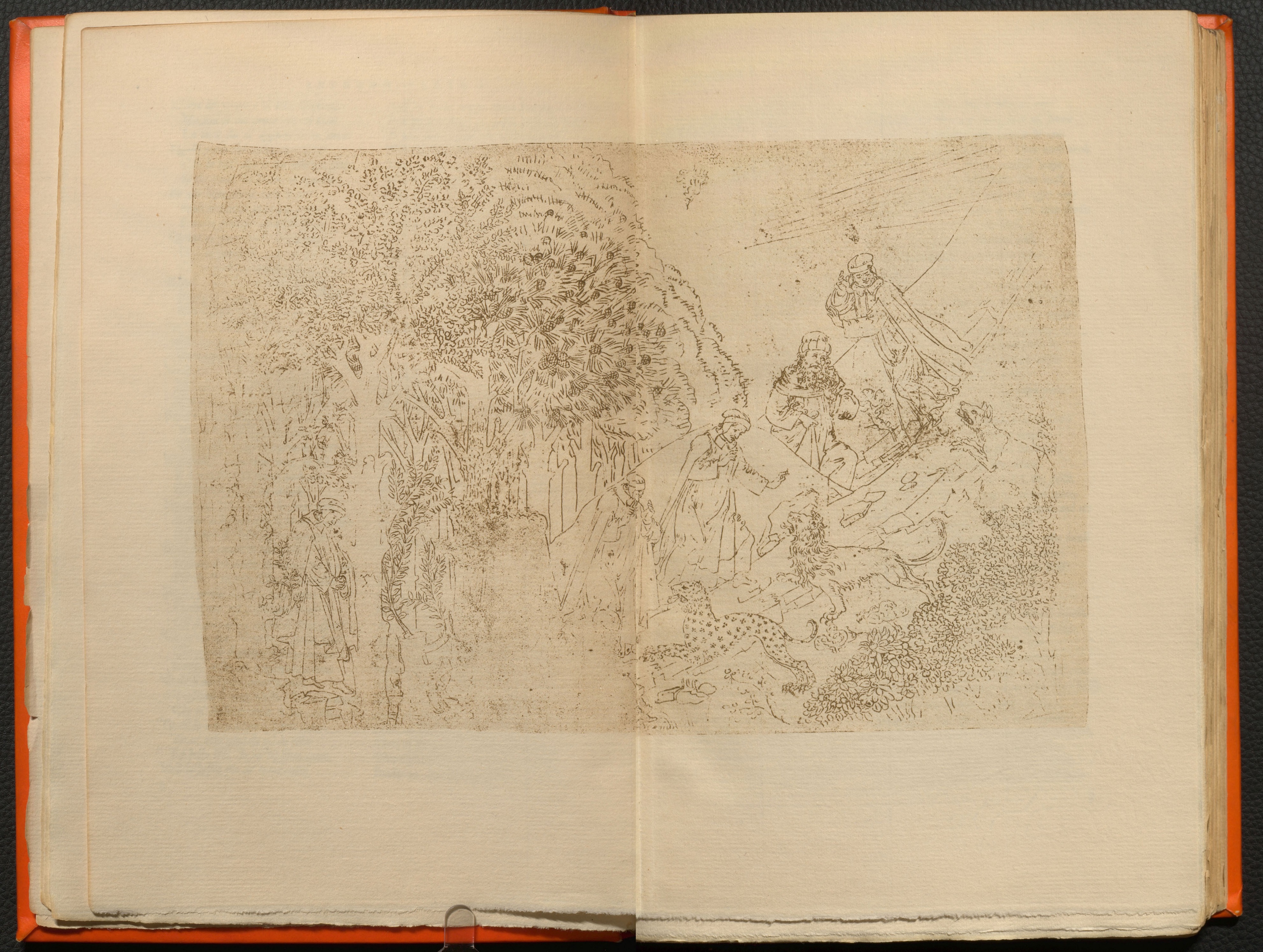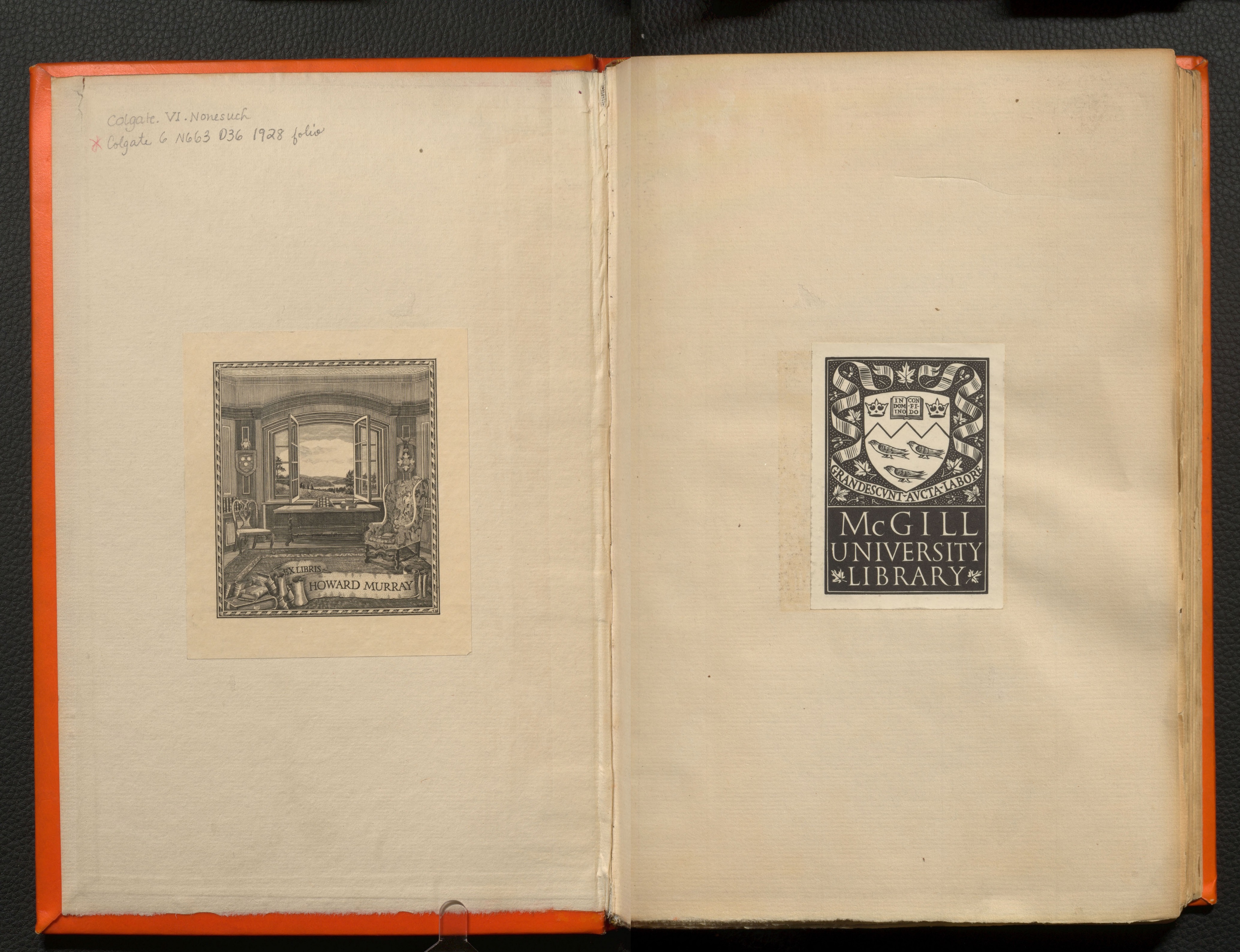This is a limited edition of Dante Alighieri's Divine Comedy. The text in Italian is taken from the version published in 1923 by Mario Casella, professor at the University of Florence and successor of Barbi as editor of the magazine “Studi Danteschi” (Sansone 1970). Opposite the Italian version can be found the English translation by Henry Francis Cary in free-verse. His version of the Divine Comedy, although not the first (William Huggins in 1761 had made an unpublished version and a second version, albeit not very accurate, is attributed to Henry Boyd in 1802), was the best known and most appreciated in England during the nineteenth century (Vincent 1970).
This bilingual edition of the Comedy is augmented by the wonderful reproductions of the drawings depicting scenes from Dante's work by the Florentine artist, Sandro Botticelli. A possible post quem date for the beginning of the works is just before 1481, the year of the first edition of the Comedy with the commentary by Cristoforo Landino published by Nicolò della Magna, active between 1470 and 1493 (Batard, 1952). The volume contains 19 engravings attributable to the style of Botticelli made by Baccio Baldini (c. 1436-1487) (Lightbown 1989). The Florentine painter, summoned to Rome at that time to fresco the Sistine Chapel, probably interrupted the series of drawings which he must have later resumed after his return to Florence (Vasari 1550). After his return to Florence he undertook a second series of drawings, one for each canto for a total of 100. The deadline for the completion of the illustrations would have been in 1497 (Horne 1986), the year Botticelli had to leave Florence for political reasons. In more recent years, based on the illustrations present in Paradise, the American Toby Yuen has suggested that the completion date would have been in the fifteen-hundreds (Yuen 1965).
The drawings were rediscovered in 1882 within the Hamilton collection in London (Venturi 1921), but the series was incomplete: only 83 of the 100 drawings were present and were eventually acquired by the Kupferstichkabinett of Berlin by its director Friedrich Lippmann (1838-1903). In 1886 they were found in the Cod. Reginense lat. 1896, part of Queen Christina's collection at the Vatican Apostolic Library, 8 other drawings. Although Botticelli's drawings were initially thought to be part of a codex (Lippmann 1896), Donati has demonstrated that they are not attributable to any edition (Donati 1962). The drawings are made on sheets of sheep parchment, which measure approximately 325 x 475 mm, with the sole exception of the Great Satan, which measures 468 x 635 mm. The illustrations were all drawn (except for the infernal chasm) on the inside and smooth side of the skin, while the text was on the outside. The illustration for the 18 Canto of Inferno is colored in tempera.

Full title: La Divina Commedia or the Divine Vision.
Author: Dante Alighieri (1265-1321); Sandro Botticelli (1444/45-1510, illustrator); Mario Casella (1886-1956, editor); Henry F. Cary (1772-1844, translator).
Content: Comedy.
Date of publication: 1928.
Place of publication: London, U.K.
Printer: The Nonesuch Press.
Language: Italian, English.
Physical description: 325 p., 320 x 200 mm. 42 illustrations (10 for Inferno, 17 for Purgatory and 15 for Paradise).
Call number: McGill Rare Books and Special Collections, folio Colgate 6 N663 D36 1928.
Catalogue: https://mcgill.on.worldcat.org/oclc/2050456
Digitisation: https://archive.org/details/McGillLibrary-rbsc_divina-commedia-divine-vision_folioColgate6N663D361928-20489

Previous owners: Howard Murray (1859-1930).
Ex-libris and Stamps: Howard Murray ex-libris on front paste-down and, on the following page, a McGill ex-libris.
History of the Copy: This book belonged to Dr. Howard Murray (1859-1930), former dean (1901-1930) of Dalhousie University. Born in New Glasgow, NS, Murray studied at the University of London and was active in educational circles in Nova Scotia.
Notes: On the fourth-to-last page can be found the number of the copy (1141 of 1475).
Bibliography
Waite, Peter. Lives of Dalhousie University. Vol. 2 : 1925-1980, the Old College Transformed. Montreal : McGill-Queen's University Press, 1998.
Enciclopedia Dantesca. 1970. S.v. "Cary, Henry Francis", by E. R. Vincent. Rome: Istituto dell’Enciclopedia Italiana. https://www.treccani.it/enciclopedia/henry-francis-cary_%28Enciclopedia-Dantesca%29/ (accessed on 20/05/2021).
Enciclopedia Dantesca. 1970. S.v. « Casella, Mario », by G.E. Sansone. Rome: Istituto dell’Enciclopedia Italiana. https://www.treccani.it/enciclopedia/mario-casella_%28Enciclopedia-Dantesca%29/ (accessed on 20/05/2021).
Batard, Yvonne. 1952. Les dessins de Sandro Botticelli pour la Divine Comedie. Paris: Perrin.
Lightbown, Ronald. 1989. Sandro Botticelli : Life and Work. London: Thames and Hudson.
Horne, Herbert. 1986. Alessandro Filipepi detto Botticelli. Florence: Studio per edizioni scelte.
Yuen, Toby. 1964-65. "New aspects of Botticelli's late works: a suggestion for the dating of the Dante illustrations", Marsyas, 41, p. 22-33.
Venturi, Adolfo. 1921. Il Botticelli interprete di Dante. Florence: Le Monnier.
Lippmann, Friedrich. 1896. Drawings by Sandro Botticelli for Dante's Divina Commedia. London: Thames and Hudson.
Donati, Lamberto. 1962. Il Botticelli e le prime illustrazioni della Divina Commedia. Florence: Olschki.
Author and date of the record: Matteo Ottaviani, 20/05/2021.